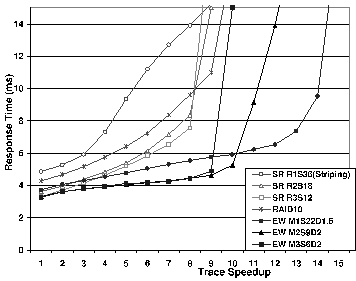



Next: Results of File System
Up: Experimental Results
Previous: Effect of Double Synchronous
Effect of the Delayed Write Buffer Size
Figure 13:
Effect on TPC-C throughput as we^M
increase the size of the delayed write buffer to 100,000 blocks.^M
The total number of disks is a constant (36).
 |
We have seen that replica propagation imposes
a significant cost on update-in-place-based disk arrays such as
RAID-10 and SR-Array. One possible way of alleviating this burden to
make these alternatives more attractive is to use a larger delayed
write buffer. A larger delayed write buffer is useful in two ways.
One is that it may allow larger batches of replica propagations to be
scheduled and these larger batches can utilize the disk bandwidth more
efficiently. The second source of efficiency is that a larger buffer
can potentially more effectively smooth the burstiness so that replica
propagation does not have to occur in the foreground due to lack of
buffer space.
Figure 13 shows the results of repeating the
throughput experiments shown in Figure 11 after
we have increased the delayed write buffer from 10,000 blocks to
100,000 blocks.
As expected, the curves representing array configurations
that require data replication have all shifted to the right, signaling
higher maximum sustainable throughput rates. However, even with this
aggressive delayed write buffering, the high cost of update-in-place
is still apparent and the advantage of eager-writing is still
significant.



Next: Results of File System
Up: Experimental Results
Previous: Effect of Double Synchronous
Chi Zhang
2001-11-16


